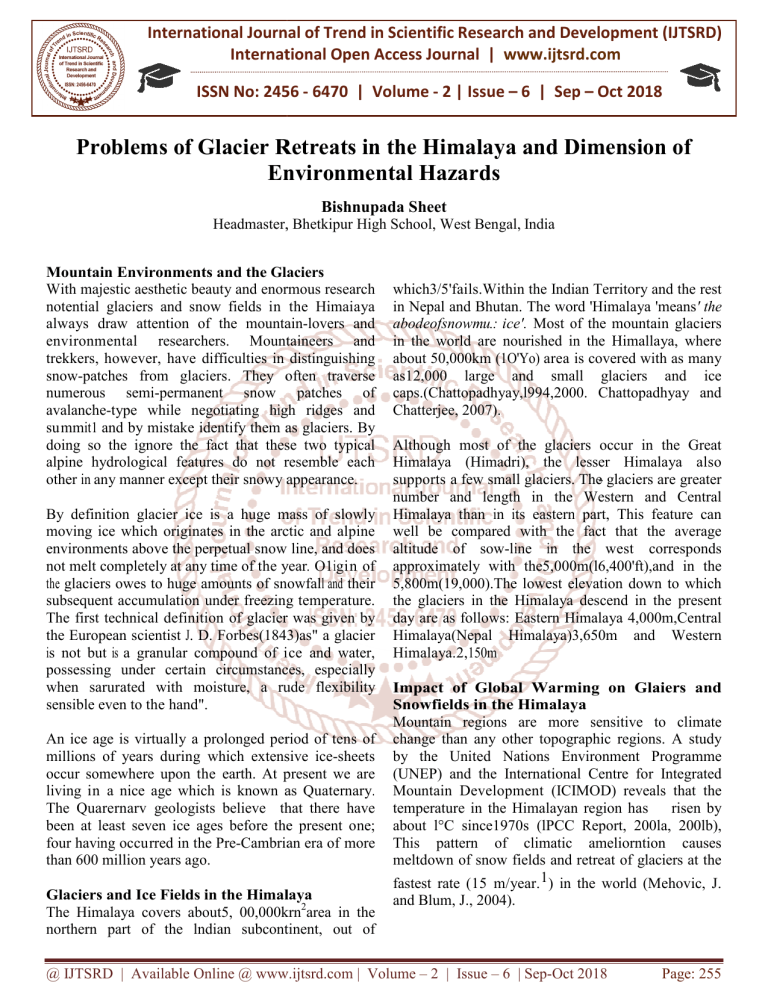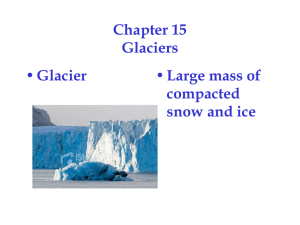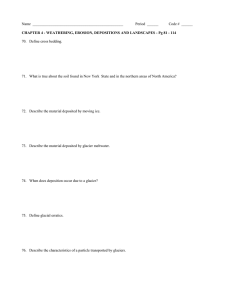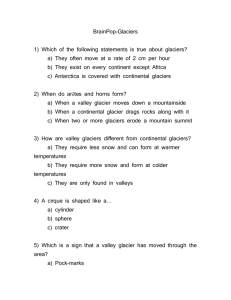
International Journal of Trend in Scientific Research and Development (IJTSRD)
International Open Access Journal | www.ijtsrd.com
ISSN No: 2456 - 6470 | Volume - 2 | Issue – 6 | Sep – Oct 2018
Problems of Glacier Retreats in the Himalaya and Dimension of
Environmental Hazards
Bishnupada Sheet
Headmaster,, Bhetkipur High School, West Bengal, India
Mountain Environments and the Glaciers
With majestic aesthetic beauty and enormous research
notential glaciers and snow fields in the Himaiaya
always draw attention of the mountain
mountain-lovers and
environmental researchers. Mountaineers and
trekkers, however, have difficulties in distinguishing
snow-patches from glaciers. They often traverse
numerous semi-permanent snow patches of
avalanche-type while negotiating high
gh ridges and
summit1 and by mistake identify them
em as glaciers. By
doing so the ignore the fact that these two typical
alpine hydrological features do not resemble each
other in any manner except their snowy appearance.
By definition glacier ice is a huge mass of slowly
moving ice which originates in the arctic and alpine
environments above the perpetual snow
ow line, and does
not melt completely at any time of the year
year. O1igin of
the glaciers owes to huge amounts of snowfal
snowfall and their
subsequent accumulation under freezing temperature.
The first technical definition of glacier was given by
the European scientist J. D. Forbes(1843)as"
(1843)as" a glacier
is not but is a granular compound of iice and water,
possessing under certain circumstances, especially
when sarurated
ted with moisture, a rude flexibilit
flexibility
sensible even to the hand".
An ice age is virtually a prolonged period of tens of
millions of years during which extensive ice-sheets
occur somewhere upon the earth. At present we are
living in a nice age which is known as Quaternary.
The Quarernarv geologists believe that there have
been at least seven ice ages before the present one;
four having occurred in the Pre-Cambrian
Cambrian era of more
than 600 million years ago.
Glaciers and Ice Fields in the Himalaya
The Himalaya covers about5, 00,000krn2area in the
northern part of the lndian subcontinent, out of
which3/5'fails.Within
Within the Indian Territory and the rest
in Nepal and Bhutan. The word 'Himalaya 'means' the
abodeofsnowmu.: ice'. Most of the mountain glaciers
in the world are nourished in the Himallaya, where
about 50,000km (1O'Yo) area is covered with as many
as12,000 large and small glaciers and ice
caps.(Chattopadhyay,l994,2000.
adhyay,l994,2000. Chattopadhyay and
Chatterjee, 2007).
Although most of the glaciers occur in the Great
Himalaya (Himadri), the lesser
lesse Himalaya also
supports a few small glaciers. The- glaciers are greater
number and length in the Western and Central
Himalaya than in its
ts eastern part, This feature can
well be compared with the fact that the average
altitude of sow-line in
n the west corresponds
approximately with the5,000m
5,000m(l6,400'ft),and in the
5,800m(19,000).The lowest elevation down to which
the glaciers
aciers in the Himalaya descend in the present
day are as follows: Eastern Himalaya 4,000m,Central
Himalaya(Nepal Himalaya)3,650m and Western
We
Himalaya.2,150m
Impact off Global Warming on Glaiers and
Snowfields in the Himalaya
Mountain regions are more sensitive to climate
change than any other topographic regions. A study
by the United Nations Environment Programme
(UNEP) and the International Centre for Integrated
Mountain Development (ICIMOD) reveals that the
temperature in the Himalayan region has
risen by
about l°C since1970s (lPCC Report, 200la, 200lb),
This pattern of climatic ameliorntion causes
meltdown of snow fields and retreat of glaciers at the
fastest rate (15 m/year.1) in
n the world (Mehovic, J.
and Blum, J., 2004).
@ IJTSRD | Available Online @ www.ijtsrd.com | Volume – 2 | Issue – 6 | Sep-Oct
Oct 2018
Page: 255
International Journal of Trend in Scientific Research and Development (IJTSRD) ISSN: 2456-6470
Reduction and Retreat of glaciers: Glaciers and
snowfields are the most valuable treasures of the
Himalaya for their both aesthetic and resource values
that contribute immensely to its total environmental
system. This
is mountain complex has as many as
1,500glaciers and along with their adjacent snow
fields they occupy about 33,000krn2areas. Recent
studies have revealed that almost 67% of the
Himalayan glaciers have reitreated mar
markedly in the
past, decades (Ageta and Kadota, 1992;; Yamda et al.
al.,
l996, Fushimi 2000).
The firn-line
line altitude of
glaciers the altitude at which both accumulation and
ablation of snow and icee on the glacier remain at
equilibrium) is steadily receding upward. And it is
estimated that the firn-line
line attitude of the glaciers in
the Western Himalaya
laya is resting at
a 50-80m higher
than the altitude during the first half of the
19thcentury (Pender, 1995).There
There records show that
the Gangotri Glacierin Garwal Himalaya is now
retreating by about 30m year”‘,
year” confirming the view
that the rate of ice melting (ablation) from this glacier
body is now foster than accum
umulation <.Sharma, B.
Rand Mc Cornick. PG2006),
The following
ing table demonstrates the pattern and rate of retreat of some important glaciiers in the Hi malaya:
Table l: Pattern and rate of retreat of some important glaciers in the We
Western
stern Himalaya
Pattern of Retreat
Total
% of
Name of glacier
Year
Rate
Retreat Retreat
1842-1935
7m/yr
0.64km
Gangtri Glacier
1.00km
12%
1935-1990
18m/yr
0.5km
1990 onwards 30m/yr
Khumbu Glacier
1953 onwards 100m/yr
5.00km
20%
(Mt. Everest expendition route in 1953)
Glacier of Baspa basin, H.P.
1962-2001
--------19%
Chota Shigri Glacier, H.P.
1990-2005
--------12%
Meola Glacier, Uttaranchal
1955-2005
34.5m/yr
--5%
Source: Alarming Facts of Warming Glaciers
Glaciers-Hasnain- S.I. (2005)
entire South Asian (Report of the International Water
Management Institute, 2004)
A retreating glacier in Nanga Parbat
Problems of dam burst and flash floods: There is
every possibility that the rapidly melting glaciers
world swell local lakes in the mountain, trigger in
gflash flooding in the narrow valleys downstre
downstream.
In 1994 a glacier lake outburst in the Lunana
region of Bhutan and flooded number of villages
below, endangering the lives of thousands of
people. The burst of the Dudh Koshi Lake in Nepal
in 1997 made similar hazards (Mehov
Mehovic and
T<l"nm. 2005). The experts maintain that that this
trend will accelerate in the ensuing years
years. Creating
social and economic problems not only for the
villages in the Himalayan
layan foothills but also for the
Variation in the river discharge pattern: As
reported in TPCC(l998)glacier
cier melt is expected to
increase even further under changed climatic
conditi ons. This would lead to increased flows in
some rivers for the first to decades in this century
followed by a reduction in flow as the glaciers
disappear. As far as the seasonal
seasona discha characterise
concerned it iss presumed that the river flows
f
will
increase from January through
ugh March f decrese from
April through September. The contribution
contr
of snow to
the run off of major river in
i the eastern Himalaya
about 10% (Sharma,1993)
993) but more than 60% in the
western Himalayas (Vohra, 1981). Because the
melting season of snow coincides ·with the summer
monsoon season, any intensification of the monsoon
is likely
ikely contribute to flood disasters in Himalayan
catchments. Such impacts willl be observed more in the
western Himalay as compared to the eastern Himalaya
as because of the higher contribution of snowmelt
runoff in the west (Sharma, l997)
997).
@ IJTSRD | Available Online @ www.ijtsrd.com | Volume – 2 | Issue – 6 | Sep-Oct
Oct 2018
Page: 256
International Journal of Trend in Scientific Research and Development (IJTSRD) ISSN: 2456-6470
At present the rivers rising from the Western
Himalaya have shown 3-4% surplus water due to a
10% increase the melting of the glaciers, and a 30%
increase for those rising from the Eastern Himalayan
glaciers. But, after 40 years, when most of these
glaciers will cease to diminish South As
Asia will have
water problems. In March 2002 UK's Department of
International Development fonded a project called
Sagarmatha (Snow and Glacier Aspects of Water
Resources Management in the Himalayas) to assess
the impact of deglaciation on the seasonal and longterm water resources in snow-fed
fed Himalayan rivers.
Parts of the finding of their studies revea
reveal some major
facts abot the melting mountain and warm
warming
glaciers. As per the report in Upper Indus, there will
be initial increases of 14% and 90% in mean flows
over the next few decades which will be followed by
decreasing flows by 30% and 90% base
baseline in the
subsequent decades in a l00-years stretch
tretch of time. For
Bhagirathi (the source stream of Ganga)
Ganga). Uttarkashi,
the fows peak will rise of the order of 20% to 33%
above baseline with in the first few decaades and them
recede to 50% of baseline after 50 years
years.
For Brahmaputrn River, near its source there is a
general decrease in decadal mean flows as glaciers are
few in the area and flows recede as the permanent
snow cover reduces with increasing tem
temperature. The
catchments in the eastern Himalaya, which benefit
from heavier precipitation of the summer monsoon,
are more vulnerable to impacts of degiaciation than
those in the west where the monsoon is much weaker.
References for further readings
1. Chattopadhyay, G. P. (l994): Morphology and
Development of Glacier-ice and the Himalaya.
Science Courier Vol5(6) , 10-14
2. Chattopadhyay, G. P. (2000): Processes and
landforms inn High altitude and high latitude areas.
In Contemporary Dimenstons Geography, edited
by N. Prasad & R Basu, (Univ. of Burdwan
Burdwan).
3. Chattopadhyay, G. P. and Chattejee, A.(2007)
global climate change and its impacts on Physical
environments and food security in south Asia.
Paper presented in the international Seminar on
Poverty & development in south asia to be held,
the Department of Geography, University of
Calcutta, Kolkata. during 11-13
11
January 2007.
4. Ch attopadhyay, G. P. (2008
2008): Recent retreats of
glaciers on the south east-facings
east
slope
Kanchenjunga summit
mit complex In the Sikkim
Himalaya. Himalayan Geology,
ology, 29(2):171-76.
29(2):
5. IPCC Report (2001):: Working Group II lmpacts,
Adaptation and Vulnerability
ty, IPCC, Cl-1-ll, ASIA.
6. Houghton, J. T., Jenkins, G. J. end Ephraums, J. J.
(1990): Climate Change: The IPCC Scientific
Assessment. Carnbridg University
Press,
Cambridge.
7. Report of the International Water Management
Institute
(2004)::
Report-Assessment
Report
and
mitigation of droughts in South-west Asia: Issues
and Prospects. Background Document for the
Regional workshop on Drought,-assessment
Drought
and
Mitigation Colombo; Sri Lanka.
8. IPCC Report (200la): Climate Change 200l;
Report of the working Group l
9. JPCC Report (2001b): Climate Change 200'1:
200
Report of the Working GroupGroup
II Impacts,
Adaptation and Vulnerability.
lnerability. IPCC , Chapter-1
Chapter
10. Mehovic, J. and Blum, J., (2005): Global Warming and
Melting Glaciers in Souih Asia: Environment, Economic
and Political Implications. SARJD Journal, Vol-1
issue-2.
11. Shanna, B. Rand Mc Cornick, P. G. (2006)
"Working Together to Respond to Climate
Change" in Annex I Expe
pert Group Seminar in
Conjunction with the OECD Global Forum on
Sustainable Development, India, on 28, March,
2006(International
(International Water Management Institute
@ IJTSRD | Available Online @ www.ijtsrd.com | Volume – 2 | Issue – 6 | Sep-Oct
Oct 2018
Page: 257





